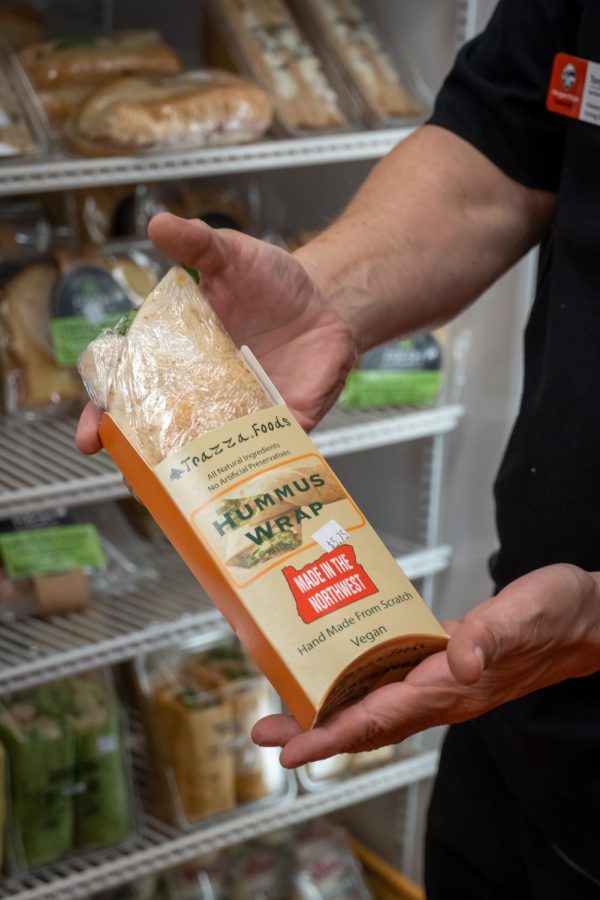The Sunny Side: Vegan and Vegetarian Options Lack Variety and Supply on OSU Campus
Tony Arp, the Retail Manager at Bites at the Memorial Union, displays one of the vegan options that the store offers on Oct. 20th. Arp states that “there were a lot of students looking for options” in regards to vegan food on campus.
November 2, 2022
Following a vegan or vegetarian diet is not an easy task, especially on the Oregon State University campus.
Just over 5.5% of the Oregon State University population follows a vegan and vegetarian diet, according to Bailey Taber, the assistant director of Dining and Nutrition and Sustainability at University Housing and Dining Services at OSU.
That percentage may seem small, but based on 2022 enrollment, that number is approximately 1,700 students.
The options for vegan and vegetarian diets need to be widespread and readily accessible throughout campus in cafes and dining halls, not limited as they are currently.
“There are a variety of vegetarian and vegan food options at each location in dining
centers across campus and at the MU restaurants managed by UHDS,” Taber said.
However, this doesn’t match what two OSU students — one vegan, one vegetarian — say. Instead, the choices on campus are perpetually unhealthy and unchanging, and in some cases, there are no options at all.
Moving to the students’ experiences, many vegan and vegetarians experience barriers when they look for food in the dining halls and cafes.
“They have the ready-made salads in the deli area, but all of them have meat,” said Maya Brisan, a first-year student and vegetarian at OSU.
As far as options go, the variety of vegan and vegetarian options are not up to scratch and lack health value, and often have added ingredients not necessary to health that prevent vegan students from purchasing them.
“A lot of things like maybe had butter on it or had bacon bits in brussel sprouts. You notice things, like it so easily could have been vegan if it was just tweaked a little bit,” said Jenna Price, a second-year student and vegan at OSU.
Price also used to buy hummus plates and vegan sandwiches, but they don’t have them at many locations anymore.
“I have friends at the University of Oregon and I’ve eaten at the UO dining hall, and they have a lot better options. I feel like overall in general, but especially for being vegan or vegetarian, they just had actual vegan and vegetarian restaurants and things like that on campus with the dining cards,” Price said.
Price said it’s frustrating to see that another university so close has vegan and vegetarian choices while many at OSU have to eat the same option every day, like tofu.
In Arnold Dining Hall, Brisan waited 30 minutes for a slice of cheese pizza because instead of keeping vegetarian options in stock, they were making pepperoni and meat specials.
“That kind of sucks just standing there waiting for my pizza. I was like ‘this is the only thing I can really eat right now, and I can’t even have it’” Brisan said.
UHDS is moving toward offering more options for vegan and vegetarian diets, however, to ensure students receive options they require for their diets, they must reach out to UHDS and leave feedback.
According to Taber, the culinary team meets often to consider new options, and student feedback they receive is a topic discussed in their meetings.
UHDS trains chefs to create recipes and receive specialized training in areas like plant-based nutrition, and they plan to continue to add more plant-based options moving forward.
From the students’ perspective, Price suggests providing nutritional variety that accommodates all diets, for example bars with rice, beans, and vegan protein to accommodate individuals whether or not they consume meat.
As a vegetarian, Brisan hopes to see more options with veggies, like paninis with something other than cheese, but tomatoes and mushrooms to create a healthier option.
The students speak out, and the answers are here. We just need to transfer the students’ experience of following a vegan or vegetarian diet to food offered in dining halls and cafes on campus.























































































































